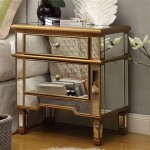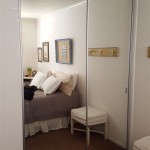How To Install a Heavy Mirror On The Wall
Installing a heavy mirror requires careful planning and execution to ensure both safety and stability. A poorly installed heavy mirror poses a serious risk of falling, potentially causing injury and property damage. This guide outlines the necessary steps to securely mount a heavy mirror on various wall types.
1. Assessing the Mirror and Wall
Before beginning the installation process, it is crucial to assess both the mirror and the wall. Determine the exact weight and dimensions of the mirror. This information will inform the selection of appropriate hanging hardware. Next, assess the wall type: drywall, plaster, concrete, or brick. Each wall type requires a specific anchoring method for optimal support.
For drywall, locating studs is vital for supporting heavy objects. A stud finder can be used to pinpoint their location. If studs are not available in the desired location, specialized heavy-duty drywall anchors, such as toggle bolts or molly bolts, are necessary.
Plaster walls, often found in older homes, can be more brittle than drywall. While locating studs is still recommended, using plaster-specific anchors might be necessary for added stability. Concrete and brick walls offer the most inherent strength. Heavy-duty concrete screws or anchor bolts are the best option for these wall types.
2. Selecting the Right Hanging Hardware
The weight of the mirror dictates the type of hanging hardware required. Standard picture hangers are unsuitable for heavy mirrors. Instead, opt for heavy-duty options specifically designed for mirrors, such as J-hooks, D-rings, or French cleats. These options distribute the weight more evenly and provide a secure grip.
J-hooks are often used in conjunction with wire attached to the back of the mirror. D-rings offer a more robust solution, especially for heavier mirrors. French cleats, consisting of two interlocking pieces, are ideal for extremely heavy mirrors, providing exceptional weight distribution and stability.
When purchasing hanging hardware, always verify the weight capacity. Choose hardware rated for a weight significantly exceeding the mirror's weight to provide a safety margin. This precaution ensures the mirror remains securely mounted even under stress.
3. Installation Process
Once the wall and mirror have been assessed and the appropriate hardware selected, begin the installation process. Mark the desired location of the mirror on the wall. Use a level to ensure the markings are straight and even. Measure the distance between the hanging points on the back of the mirror and transfer these measurements to the wall markings.
If installing into drywall and using anchors, drill pilot holes at the marked locations using a drill bit slightly smaller than the anchor's diameter. Insert the anchors following the manufacturer's instructions. If installing into concrete or brick, use a masonry drill bit to create the pilot holes for the concrete screws or anchor bolts. Ensure the holes are deep enough to accommodate the chosen hardware.
Attach the chosen hanging hardware to the wall, ensuring they are securely fastened. Then, carefully lift the mirror and align the hanging hardware on the back of the mirror with the corresponding hardware on the wall. Gently lower the mirror onto the hardware. Double-check the mirror’s stability by applying gentle pressure to various points. If the mirror feels secure, the installation is complete.
4. Safety Precautions
Throughout the entire installation process, prioritize safety. Wear appropriate safety glasses to protect your eyes from dust and debris. Use work gloves to protect your hands when handling sharp objects and heavy materials. If the mirror is exceptionally large or heavy, enlist the help of another person to lift and position it safely.
After installation, periodically inspect the hanging hardware and wall anchors for any signs of wear or damage. If any issues are detected, address them promptly to prevent potential accidents. Consider using safety backing film on the back of the mirror. This film will help contain the glass shards if the mirror were to break, minimizing the risk of injury.
By following these steps and taking necessary precautions, installing a heavy mirror can be accomplished effectively and safely, ensuring a beautiful and secure addition to any space.
How To Hang A 100 Pound Mirror On Drywall Quora

How To Hang A Heavy Mirror C R F T

How To Hang A Heavy Mirror With Pictures Wikihow

A Better Way To Hang Heavy Mirror Hanging Brackets

How I Installed A Really Big Mirror Merrypad Diy Network

How I Installed A Really Big Mirror Merrypad Diy Network

How To Hang Something Heavy Like A Pro Calling It Home Mirror Hanging

How To Hang A Heavy Mirror Diy Family Handyman

How To Hang A Heavy Mirror C R F T

How To Hang A Heavy Mirror On Thick Wall Repair Your Home








